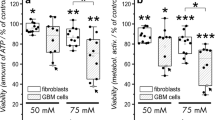Summary
The effect of dimethylsulfoxide (DMSO) and iododeoxyuridine (IUdR) on the growth characteristics of two established human glioblastoma cell lines (FG and HMCN-1) was studied. The FG cell line has been characterized. The HMCN-1 cell line, established in our laboratory, consisted of fibroblastoid and polygonal cells that grew without contact inhibition. Subcutaneous injection of these cells into weanling athymic nude mice induced slowly growing, solid tumors that were histologically spindly with areas that were similar to the original tumor. Chromosomal analyses revealed a human heteroploid pattern with a modal number of 69. The cells of the original human glioma contained S-100 protein and glial fibrillary acidic protein (GFA protein), whereas the established cells failed to express markers. Prolonged treatment of glioma cells with DMSO generated a more adherent, normal human fibroblastoid phenotype that grew with contact inhibition. The new phenotype and proliferative restriction of these cells was evident as late as 50 days after discontinuation of treatment. The chemical induction of cell differentiation resulted in decreased tumorigenic potential in athymic nude mice.
Similar content being viewed by others
References
Friend C, Scher W, Holland JG, Sato T: Hemoglobin synthesis in murine virus-induced leukemic cells in vitro: stimulation of erythroid differentiation by dimethylsulfoxide. Proc Natl Acad Sci USA 68:378–382, 1971
Boyer SH, Wuu KD, Noyes AN, Young R, Scher W, Friend C, Preisler HD, Bank A: Hemoglobin biosynthesis in murine virus-induced leukemic cells in vitro: structure and amounts of globin chains produced. Blood 40:823–835, 1972
Ross J, Ikawa Y, Leder P: Globin messenger-RNA induction during erythroid differentiation of cultured leukemia cells. Proc Natl Acad Sci USA 69:3620–3623, 1972
Tereda M, Fried J, Nudel U, Rifkind RA, Marks PA: Transient inhibition of initiation of S-phage associated with dimethylsulfoxide induction of murine erythroleukemia cells to erythroid differentiation. Proc Natl Acad Sci USA 74:248–252, 1977
Collins SJ, Ruscetti FW, Gallagher RE, Gallo RC: Terminal differentiation of human promyelocytic leukemia cells induced by dimethylsulfoxide and other polar compounds. Proc Natl Acad Sci USA 75:2458–2462, 1978
McKeever PE, Quindlen E, Banks MA, Williams U, Kornblith PL, Laverson S, Greenwood MA, Smith B: Biosynthesized products of cultured neuroglial cells. I. Selective release of proteins by cells from human astrocytomas. Neurology 31:1445–1152, 1981
Shitara N, McKeever PE, Whang-Peng J, Knutsen T, Smith BH, Kornblith PL: Flow cytometric and cytogenic analysis of human cultured cell lines derived from high-low grade astrocytoma. Acta Neuro Pathol (Berlin) 60:40–48, 1983
Caspersson T, Lomakka G, Zech L: The 24 fluorescence patterns of the human metaphase chromosomes: distinguishing characters and variability. Hereditas 67:89–94, 1971
Borenfreund E, Steinglass M, Korngold G, Bendich A: Effect of dimethylsulfoxide and dimethylformamide on the growth and morphology of tumor cells. Ann NY Acad Sci 243:164–171, 1975
Kimhi Y, Palfrey C, Spector I, Barak Y, Littauer UZ: Maturation of neuroblastoma cells in the presence of dimethylsulfoxide. Proc Natl Acad Sci USA 73:462–466, 1976
Kim YS, Tsao D, Siddiqui B, Whitehead JS, Arnstein P, Bennett J, Hicks J: Effects of sodium butyrate and dimethylsulfoxide on biochemical properties of human colon cancer cells. Cancer 45:1185–1192, 1980
Tralka TS, Rabson AS: Cilia formation in cultures of human lung cancer cells treated with dimethylsulfoxide. J Natl Cancer Inst, 57:1383–1388, 1976
Fulling KH, Nelson JS: Cerebral astrocytic neoplasms in the adult: contribution of histologic examination to the assessment of prognosis. Sem Diagn Pathol 1:152–163, 1984
Frankel S, German WJ: Glioblastoma multiforme: review of 219 cases with regard to natural history, pathology, diagnostic methods and treatment. J Neurosurg 15:489–503, 1958
Scherer HJ: The forms of growth in gliomas and their practical significance. Brain 63:1–35, 1940
Bigner DD, Bigner SH, Poten J, Westermark B, Mahaley MS, Ruoslathi E, Herschman H, Eng LF, Wikstrand CJ: Heterogeneity of genotypic and phenotype characteristics of 15 permanent cell lines derived from human gliomas. J Neuropath Exp Neurol 40:201–229, 1981
Bigner SH, Bullard DE, Pegram CN, Wikstrand CJ, Bigner DD: Relationship of in vitro morphologic and growth characteristics of established human glioma-derived cell lines to their tumorgenicity in athymic nude mice. J Neuropath Exp Neurol 40:390–409, 1981
Jones TR, Bigner SH, Schold SC, Eng LF, Bigner DD: Anaplastic human gliomas grown in athymic mice. Am J Pathol 105:316–327, 1981
Author information
Authors and Affiliations
Rights and permissions
About this article
Cite this article
Geder, L., Kreider, J.W., Towfighi, J. et al. Effect of differentiation inducers on growth characteristics of human glioma cell lines. J Neuro-Oncol 5, 251–271 (1987). https://doi.org/10.1007/BF00151230
Issue Date:
DOI: https://doi.org/10.1007/BF00151230




